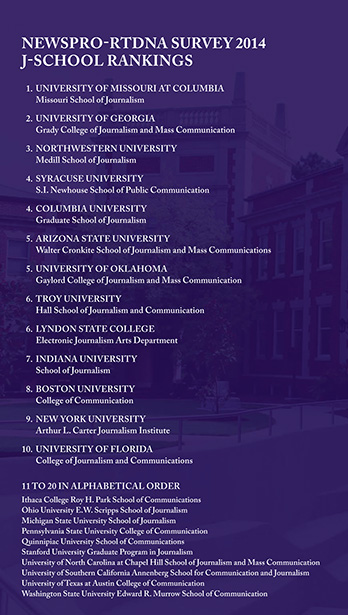The University of Missouri at Columbia’s School of Journalism was once again far and away the No. 1 choice as the top J-school in the country in the annual NewsPro-RTDNA Top Journalism Schools poll of news professionals.
Missouri handily claimed the top spot in the 2014 survey, trailed by second-place University of Georgia’s Grady College of Journalism and third-place Northwestern University’s Medill School of Journalism and Mass Communication.
A series of ties followed. Syracuse University’s S.I. Newhouse School of Public Communications and the Columbia University Graduate School of Journalism tied for fourth place, while the Walter Cronkite School of Journalism and Mass Communication at Arizona State University and the University of Oklahoma’s Gaylord College of Journalism and Mass Communication tied for fifth place. Tied for sixth were Troy University’s Hall School of Journalism and Communication and Lyndon State College’s Electronic Journalism Arts Department. Rounding out the top 10 were Indiana University School of Journalism, in seventh place, Boston University College of Communication in eighth, New York University’s Arthur L. Carter Journalism Institute in ninth and, in 10th place, the University of Florida’s College of Journalism and Communications.
The survey was distributed on TVWeek.com and to members of the Radio Television Digital News Association, with 673 respondents participating. A total of 607 of those respondents answered the question about their professional status; of those, 260 (42.8%) said they were news professionals. Additionally, 169 (27.8%) answered non-news professionals, 104 (17.1%) identi?fied as students, and 74 (12.2%) said they were educators.
The 106-year-old Missouri School of Journalism — the oldest J-school in the country, if not the world — is known for its “Missouri Method” that enables students to receive hands-on training in real news media, including the school-owned KOMU-TV, the NBC/CW a ?ffiliate for Columbia and nearby Jefferson City, Mo. UM also operates the local National Public Radio station, KBIA, and produces “Radio Adelante,” a Spanish-language radio program. Some of the approximately 2,250 Missouri School students also get practical experience at the school’s Columbia Missourian publications, which include a website, a digital suite of apps, a print publication and e-books, and at Vox Magazine, which publishes a weekly iPad edition and a daily culture and entertainment blog called VoxTalk.
Asked why they selected a certain school as their top choice, responders were quite detailed in their answers. As can be expected, the Missouri School time and again won praise for its real-world approach. “The Missouri Method. You get real world, hands-on experience (and lots of it) before you even graduate,” wrote one of the many school’s supporters. A University of Georgia advocate explained, “University of Georgia’s Grady College of Journalism and Mass Communication has well-trained professors who truly care about giving students experience in all areas of telecommuncations. It shows with the wide range of Grady students involved in the journalism industry around the country.”
Several respondents put it more succinctly: “Columbia’s graduates have a proven track record of success,” and, from a University of Florida fan, “Gators succeed in all aspects of the industry. The hands-on training prepares future professionals.” Many responders took great pains to boost Troy University in Alabama. “Troy University focuses on many aspects of journalism from print, broadcast, and new media. Troy does a good job of preparing all platform journalist to enter the workforce upon graduation. The curriculum at Troy is the best, with outstanding professors that give hands-on experience.”
A respondent who named University of Oklahoma the No. 1 school explained, “The University of Oklahoma is an often-overlooked leader in journalism education. The faculty set is a balanced mix of researchers and practitioners, giving students a healthy mix of cutting-edge research and on-the-job application. The Gaylord College houses an integrated advertising agency within its halls as well as a state-of-the-art broadcasting facility. It’s a playground for future storytellers that should be commended on its rise in recent years.”
Arizona State was the top choice of a respondent who commented, “Their program is comprehensive, interactive and ever-evolving to keep up with a continually changing fi eld. From cutting-edge technologies, top-tier professors and opportunity for student innovation, the Cronkite school leads the nation in developing the communications professionals of the future.”
The Electronic Journalism Arts department at 1,400-student Lyndon State College in Lyndonville, Vt., had a strong showing for the second straight year — and, like the Missouri School, was favored for its in-the-trenches approach to teaching. One news professional explained, “Lyndon State College is a small school made up of a very few students in the Broadcast Journalism Department. The students turn out a nightly, live broadcast of local news in the Northeast Kingdom and surrounding towns of Vermont (and New Hampshire). Not only has this journalism program taken home Emmy awards, they consistently turn out an amazing 5:30 broadcast on the backs of only the students!”
Those in the midst of the learning process chimed in as well. An Indiana University student sang these praises: “I am a student at Indiana University Southeast, and I feel that the skills I have already gained there give me and edge on the competition. I stepped into this program having a strong grasp on writing, but knew little to nothing about journalistic writing or the myriad of storytelling tools available in the digital age. I now feel equipped to go cover any kind of story, with many, many tools in my arsenal, and I haven’t even graduated yet.” Asked what the single most important course a J-school can offer, a great many respondents replied “ethics” and “social/digital media.”
Other responses varied from “experience is by far the most important thing for a journalism student to gain in school” to “law and regulation,” "investigative reporting” and “how to straddle multiple delivery platforms in the Internet age.” One respondent just called for a return to the fundamentals: “Basics of reporting, which would include writing and truly understanding developing sources and interviewing people.” Another advocated a focus on local journalism, off ering, “Story development on a local level. So many news outlets go with the major, AP news and that’s it. Students need to understand how to connect BIG stories with local interests.”
The remaining J-schools in the top 20 choices of news professionals were, Ithaca College’s Roy H. Park School of Communications, Ohio University’s E.W. Scripps School of Journalism, Michigan State University’s School of Journalism, Pennsylvania State University’s College of Communication, Quinnipiac University’s School of Communications, Stanford University’s Graduate Program in Journalism, University of North Carolina at Chapel Hill’s School of Journalism and Mass Communication, University of Southern California’s Annenberg School for Communication and Journalism, University of Texas at Austin’s College of Communication and Washington State University’s Edward R. Murrow School of Communication.





